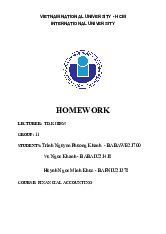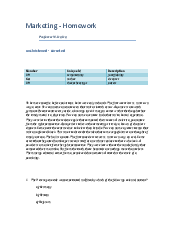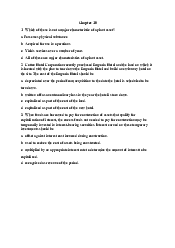









Preview text:
lOMoARcPSD|359 747 69 Midterm Test 1 MIDTERM TETS 1 QUESTION 1 (30 Marks)
1. A trial balance prepared after adjustments have been recorded is called a(n): a. Balance sheet b. Adjusted trial balance c. Unadjusted trial balance d. Classified balance sheet
2. A trial balance prepared before any adjustments have been recorded is: a. An adjusted trial balance
b. Used to prepare financial statements
c. An unadjusted trial balance
d. Correct with respect to proper balance sheet and income statement amounts
3. A company had sales of $695,000 and cost of goods sold of $278,000. Its gross margin equals: a. $(417,000) b. $695,000 c. $278,000 d. $417,000
4. A record of the increases and decreases in a specific asset, liability, equity, revenue, or expense is a(n): a. Journal b. Posting c. Trial balance d. Account 5. Gross profit:
a. Is also called gross margin
b. Less other operating expenses equals income from operations
c. Must cover all operating expenses to yield a return for the owner of the business d. All of these lOMoARcPSD|359 747 69 TEST 1
6. Which of the following statement is correct? Financial Accounting 1
a. When a future expense is paid in advance, the payment is normally recorded in a
liability account called Prepaid Expense.
b. Promises of future payment are called accounts receivable
c. Increases and decreases in cash are always recorded in the owner’s capital account
d. An account called Land is commonly used to record increases and decreases in
both the land and buildings owned by a business
7. A company pays each of its two office employees each Friday at the rate of $100 per
day for a five-day week that begins on Monday. If the monthly accounting period ends
on Tuesday and the employees worked on both Monday and Tuesday, the month-end
adjusting entry to record the salaries earned but unpaid is:
a. Dr. Unpaid Salaries $600 and Cr. Salaries Payable $600
b. Dr. Salaries Expense $400 and Cr. Salaries Payable $400
c. Dr. Salaries Expense $600 and Cr. Salaries Payable $600
d. Dr. Salaries Expense $400 and Cr. Cash $400
8. An asset created by prepayment of an expense is:
a. Recorded as a debit to an unearned revenue account
b. Recorded as a debit to a prepaid expense account
c. Recorded as a credit to an unearned revenue account
d. Not recorded in the accounting records until the earnings process is complete 9.
The adjusting entry to record the earned but unpaid salaries of employees at the
end of an accounting period is:
a. Dr. Unpaid Salaries and Cr. Salaries Payable
b. Dr. Salaries Expense and Cr. Cash
c. Dr. Salaries Expense and Cr. Salaries Payable Financial Accounting 2 lOMoARcPSD|359 747 69 TEST 1
d. Dr. Cash and Cr. Salaries Expense
10. A liability created by the receipt of cash from customers in payment for products or
services that have not yet been delivered to the customers is:
a. Recorded as a debit to unearned revenue account
b. Recorded as a debit to prepaid expense account
c. Recorded as a credit to an unearned revenue account
d. Recorded as a credit to a prepaid expense account 11. Cost of goods sold:
a. Is another term for merchandise sales
b. Is the term used for the cost of buying and preparing merchandise for sale
c. Is another term for revenue
d. Is also called gross margin 12. A merchandising company:
a. Earns net income by buying and selling merchandise
b. Receives fees only in exchange for services
c. Earns profit from commissions only
d. Earns profit from fares only
13. The Income Summary account is used:
a. To adjust and update asset and liability accounts
b. To close the revenue and expense accounts
c. To determine the appropriate withdrawal amount
d. To replace the capital account in some businesses Financial Accounting 3 lOMoARcPSD|359 747 69 TEST 1
14. The special account used only in the closing process to temporarily hold the amounts
of revenues and expenses before the net difference is added to (or subtracted from) the
owner’s capital account is the: a. Income Summary account b. Closing account c. Balance column account d. Contra account
15. Generally Accepted Accounting Principles:
a. Are based on long used accounting practices
b. Are basic assumptions, concepts, and guidelines in preparing financial statements
c. Are detailed rules used in reporting on business transactions and events d. All of these
16. The double-entry system requires that each transaction must be recorded:
a. In at least two different accounts b. In two sets of books
c. In a journal and in a ledger
d. First as a revenue and then as an expense 17. A journal provides
a. The balances for each account
b. Information about a transaction in several different places
c. A chronological record of transactions
d. A list of all accounts used in the business
18. The accounting process involves all of the following except
a. Identifying economic transactions that are relevant to the business
b. Communicating financial information to users by preparing financial reports
c. Recording economic events that change the financial position of the business
d. Reporting the predicted future performance of the business to users Financial Accounting 4 lOMoARcPSD|359 747 69 TEST 1
19. The common characteristic possessed by all assets is a. Long life b. Future economic benefit c. Tangible nature d. Great monetary value
20. Retained earnings at the end of the period is equal to:
a. Retained earnings at the beginning of the period plus net income minus liabilities
b. Retained earnings at the beginning of the period plus net income minus dividends c. Net income d. Assets plus liabilities
21. The credit terms 2/10, n/30 are interpreted as:
a. 2% cash discount if the amount is paid within 10 days, or the balance due in 30 days
b. 10% cash discount if the amount is paid within 2 days, or the balance due in 30 days
c. 30% discount if paid within 2 days
d. 30% discount if paid within 10 days 22. A trade discount is:
a. A term used by a purchaser to describe a cash discount given to customers for prompt payment
b. A reduction in price below the list price
c. A term used by a seller to describe a cash discount granted to customers for prompt payment
d. A reduction in price for prompt payment Financial Accounting 5 lOMoARcPSD|359 747 69 TEST 1
23. The amount recorded for merchandise inventory includes: a. Any purchase discounts b. Any returns and allowances c. Any trade discounts d. All of these
24. A company uses the perpetual inventory system and recorded the following entry: Dr. Account Payable 2,500 Cr. Merchandise Inventory 50 Cr. Cash 2,450 This entry reflects a: a. Purchase b. Return c. Sale
d. Payment of the account payable and recognition of a cash discount taken 25. A debit memorandum is:
a. Required whenever a journal entry is recorded
b. The source document for the purchase of merchandise inventory
c. Required when a purchase discount is granted
d. The document a buyer issues to inform the seller of a debit made to the seller’s
account in the buyer’s records.
26. A company purchased $1,800 of merchandise on December 5. On December 7, it
returned $200 worth of merchandise. On December 8, it paid the balance in full, taking
a 2% discount. The amount of the cash paid on December 8 equals: a. $200 b. $1,564 c. $1,568 d. $1,600 Financial Accounting 6 lOMoARcPSD|359 747 69 TEST 1
27. A company purchased $4,000 worth of merchandise. Transportation costs were an
additional $350. The company later returned $275 worth of merchandise and paid the
invoice within the 2% cash discount period. The total amount paid for this merchandise is: a. $3,725 b. $3,925 c. $3,995 d. $4,000.5 e. $4,075
28. A buyer failed to take advantage of the vendor’s credit terms of 2/15, n/45, but instead
paid the invoice in full at the end of 60 days. By not taking advantage of the cash
discount, the buyer lost the equivalent of …………annual interest on the amount of the purchase. a. 12.2% b. 16.2% c. 18.9% d. 24.3%
29. Merchandising companies must account for: a. Sales b. Sales discounts c. Cost of merchandise sold e. All of these
30. If the liabilities of a business increased $75,000 during a period of time and the owner’s
equity in the business decreased $30,000 during the same period, the assets of the business must have: Financial Accounting 7 lOMoARcPSD|359 747 69 TEST 1 a. Decreased $105,000 b. Decreased $45,000 c. Increased $30,000 d. Increased $45,000 e. Increased $105,000 QUESTION 2 (30 Marks)
At the beginning of June, Brooke Gable started up a business called ABC Company. ABC
provides custom computer services/solutions. The company had the following transactions during April:
a. Brooke Gable contribute the capital of $50,000 by the cash of $28,000 and the office equipment of $22,000.
b. The company purchased land worth $20,000 by paying $5,000 cash and signing a
long-term note payable for $15,000.
c. The company paid $5,000 cash for at two-year insurance policy.
d. The company provided services to a client and immediately collected $4,200 cash.
e. The company completed $4,000 of services for a client. This amount is to be received within 30 days.
f. The company purchased office equipment of $1,500 on account.
g. The company completed client services for $8,200 on credit.
h. The company collected $5,500 cash in partial payment from the client described in transaction (g).
i. The company paid $5,500 cash for wages to an assistant.
j. The company paid $1,000 cash for advertisements in the local newspaper during April. Required:
1. Journalize the transactions (10 marks). Financial Accounting 8 lOMoARcPSD|359 747 69 TEST 1
2. Prepare following T-Accounts and calculate the balances (ending value): Cash,
Accounts Receivable, Prepaid Insurance, Office Equipment, Land, Account
Payable, Note Payable, Capital, Fees Earned, Advertising Expense and Wages Expense (10 marks).
3. Prepare an unadjusted trial balance as of the end of April (10 marks). QUESTION 3 (10 Marks)
The following information relates to EFG, December 31, 2009. The company, which uses
the calendar year as its annual reporting period, initially records prepaid and unearned
items in balance sheet accounts (assets and liabilities, respectively). Prepare the adjusting entries on December 31, 2009.
a. The company’s weekly payroll is $5,000, paid each Friday for 5 workweeks.
Assume December 31, 2009, falls on Monday, but the employees will not be paid
their wages until Friday, January 4, 2010.
b. On October 1, 2009, the company agreed to work on a new housing development.
The company is paid $150,000 on October 1 in advance of future installation of
similar alarm systems in 24 new homes. That amount was credit to the Unearned
Services Revenue account. Between October 1 and December 31, work on 20 homes was completed.
c. On September 1, 2009, the company purchased a 12-month insurance policy for
$1,800. The transaction was recorded with $1,800 debit to Prepaid Insurance.
d. On December 29, 2009, the company completed a $7,000 service that has not been
billed and not recorded as of December 31, 2009. Financial Accounting 9 lOMoARcPSD|359 747 69 TEST 1 QUESTION 4 (30 Marks)
Prepare journal entries to record the following merchandise transaction both the seller
(BMX – 15 marks) and the buyer (Sanuk – 15 marks).
a. May 4 – BMX sold $1,500 of merchandise on account to Sanuk, term FOB
shipping point n/45, invoice dated May 4. The cost of merchandise sold was $900.
b. May 6 – Sanuk paid transportation charges of $30 on the May 4 purchase from BMX,
c. May 8 – BMX sold $1,000 of merchandise on account to Sanuk, terms FOB
destination, n/30, invoice dated May 8. The cost of merchandise sold was $700.
d. May 10 – BMX paid transportation costs of $50 for delivery of merchandise sold to Sanuk on May 8.
e. May 16 – BMX issued Sanuk a $200 credit memorandum for merchandise
returned. The merchandise was purchased by Sanuk on account on May 8. The
cost of merchandise returned was $140.
f. May 28 – BMX received payment from Sanuk for purchase of May 8.
g. May 21 – BMX sold $2,400 of merchandise on account to Sanuk, terms FOB
shipping point, 2/10, n/eom. BMX prepaid transportation costs of $100, which
were added to the invoice. The cost of merchandise was $1,440.
h. May 31 – BMX received payment from Sanuk for purchase of May 21, less discount (2% x $2,400). Financial Accounting 10
Document Outline
- QUESTION 1 (30 Marks)
- QUESTION 2 (30 Marks)
- QUESTION 4 (30 Marks)




